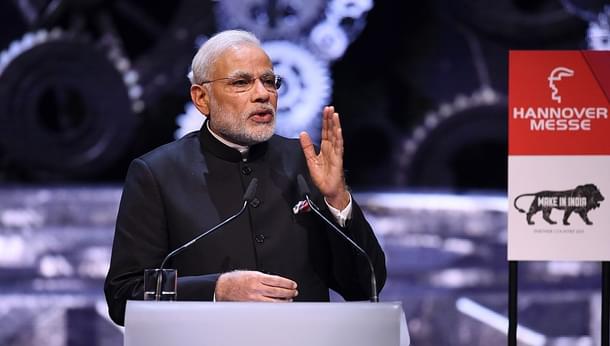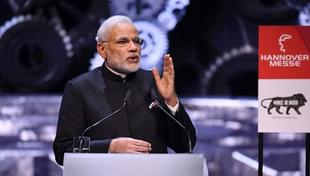World
How Modi Has Given India’s Foreign Policy An Economic Agenda
Rajiv Bhatia
May 16, 2016, 02:55 PM | Updated 02:55 PM IST
Save & read from anywhere!
Bookmark stories for easy access on any device or the Swarajya app.


In February 2015, India’s ambassadors and other senior diplomats stationed around the globe assembled in New Delhi to hear Prime Minister Modi voice his conviction that they should all be committed to “diplomacy for development”.
In early 2016, India’s External Affairs Minister Sushma Swaraj released an attractive, colourful e-booklet titled “Diplomacy for Development”. It presented a scorecard for 2015, highlighting the three Ps—“path-breaking, proactive and pragmatic”—that encapsulate the development-centric diplomatic initiatives and outreach of the Modi government. The year 2015 was presented as “a milestone year” for “dovetailing diplomacy and development”.
Are we, consequently, witnessing a new genre of diplomacy?
In his classic book Diplomacy, Harold Nicolson refers to five meanings of diplomacy: as a synonym for “foreign policy”, “negotiation”, “the processes and machinery” of negotiation, the diplomatic service, and “an abstract quality or gift” positively implying “skill in the conduct of international negotiation”, or negatively, “the more guileful aspects of tact”. He then settles for the neutral definition offered by the Oxford English Dictionary: “diplomacy is the management of international relations by negotiation”
In the past, diplomacy used to focus on war and peace, security, trade, and other national interests. Even today, India is concerned with all those objectives but special priority is now attached to deploying diplomacy to accelerate the nation’s development in a broad sense. Although “development” is much more than mere GDP growth, it is difficult to envisage economic development without the latter, especially in a developing country.
Hence, economic diplomacy remains the core of diplomacy for development. An expert has observed that economic diplomacy has two facets: economy for diplomacy and diplomacy for economy. Essentially, it stands for promoting convergence of the strategic, political, and economic interests of a nation, with special stress placed on development issues.
The impact of the economy and geoeconomics on foreign policy has been well understood in the Indian establishment for long. Even in the earlier eras, when the Indian economy was weak and vulnerable, persistent diplomacy was needed to ensure the timely arrival of PL480 shipments of American wheat and, later, containers of milk powder from the EU that facilitated the “white revolution” in India. After two generations of experience in economic diplomacy that began with the oil crisis in 1973, government institutions have amassed huge knowledge of and expertise in the dynamics of inter-linkage between trade in goods and services, intellectual property rights issues, climate change, energy security, sustainable development, cyber governance, and development cooperation. The previous government, headed by PM Manmohan Singh, had established a direct linkage between the country’s development goals and foreign policy.
What then is novel and striking in the Modi government’s approach over the past two years? In the current partisan atmosphere, it needs to be defined with studied objectivity: First, the Prime Minister’s clear articulation, passion, and vigour have convinced most, other than die-hard critics, that a fast, inclusive, and sustainable socio-economic development of India is the government’s primary goal. To achieve this mission, increased cooperation with external partners and effective diplomacy have a critical contribution to make.
Secondly, the nation’s principal development objectives have been specifically defined, converted into projects, and then showcased as new initiatives under catch phrases like “Make in India”, “Skill India”, “Digital India”, and “Clean India.” The acumen seen in organising mega events and campaigns around such initiatives had hitherto never been witnessed.

Thirdly, development issues have consistently been assigned a central place in India’s interactions with world leaders, both at home and abroad: “By opening India’s doors to foreign expertise and leveraging multiple partnerships for common benefit,” the Ministry of External Affairs claims, “Indian diplomacy seeks to take the goal of foreign policy for domestic transformation for the common man further than ever before.”
Of course, two years may be regarded as too brief a period to measure the impact of the current government’s strategy. Feedback from abroad suggests the world’s perception of India has turned positive, but the accompanying response has been that the government needs to focus on more economic reforms like improving the ease of doing business in India, and implementation issues. Economic data presents a mixed picture: in 20 months of the Modi government, India received $85 billion in foreign investment as compared to $59 billion in a similar, preceding period. Exports, however, declined 16% in 2015–16. [1]
Advancing on the path of 8% annual growth and spreading the fruits of development fairly—to weaker sections of society— have to be the overarching goals of the Indian government. In this context, lowering the political temperature, consensus building and conciliatory politics, and notable improvement in governance seem to be the prerequisites. Speedy progress on various projects for infrastructure development, connectivity, job creation, smart cities and making “Rising India” happen, should be our shared goals.
Pondering over the future, the common (but well-informed) citizen may look forward to the arrival of Indian goods at Gwadar Port for onward shipment to Afghanistan and Central Asia, to bus travel by Northeastern tourists to Yangon and Bangkok through the Trilateral Highway, and to watching the Yamuna turn from a filthy and dying rivulet into the rich and sparkling river of yore. Only then, “diplomacy for development” will be rated as an indisputable reality. It will be a day worth waiting for!
References
[1] Department of Industry Policy and Promotion, Government of India, FDI Statistics, <http://dipp.nic.in/English/Publications/FDI_Statistics/FDI_Statistics.aspx>
This piece was first published at www.gatewayhouse.in and has been republished here with permission. ‘Gateway House’ is a Mumbai-based foreign policy think-tank.
Rajiv Bhatia is Distinguished Fellow, Foreign Policy Studies Programme, Gateway House, a former high commissioner to South Africa, and a regular commentator on international affairs.





